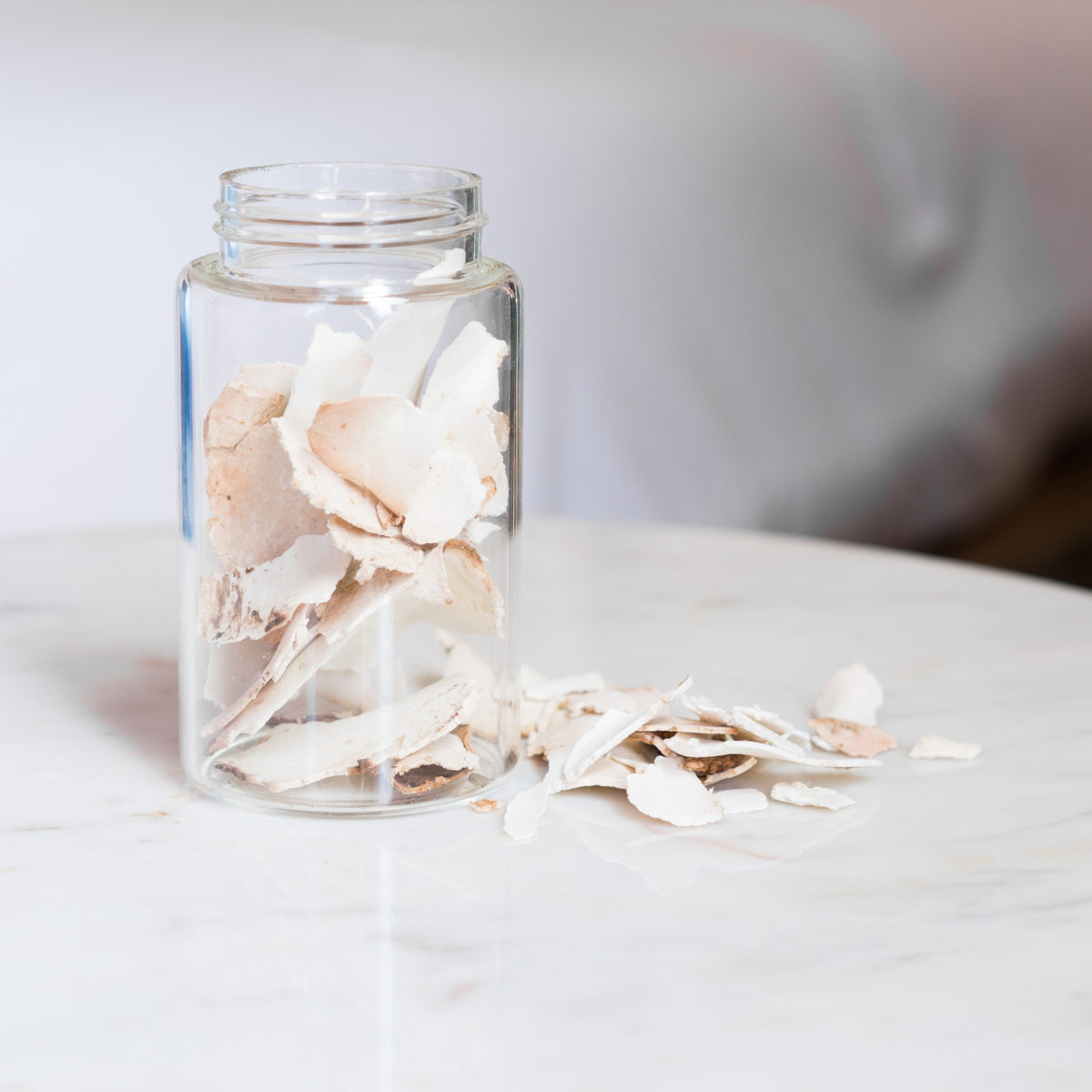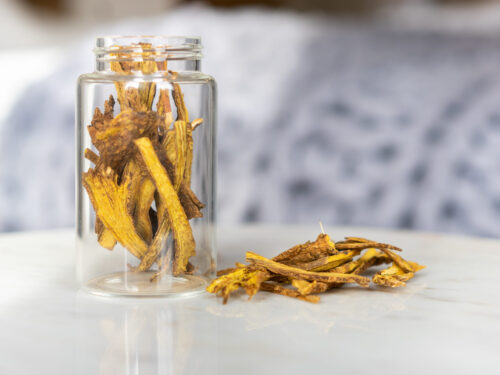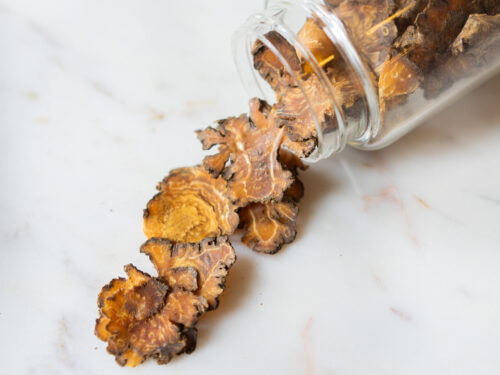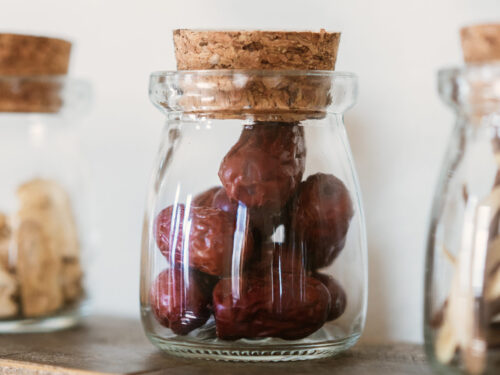
COMMON NAME (Chinese Name)
Poria (Fu Ling)
BOTANICAL NAME
Wolfiporia Extensa
COMMON NAMES
Hoelen; Poria Cocos; Poria Cocos Wolf; Indian Bread
USES
Poria owes its medicinal effects to chemical compounds that may impact kidney function, reduce inflammation, and suppress immune function. It follows, then, that Poria has a known diuretic effect when ingested and may cause dramatic increases to urine output when taken regularly. What’s more, because it reduces inflammation by inhibiting the inflammatory response (rather than by impacting circulation), Poria shows potential promise as a safe at-home treatment for fever, headache, and trauma-related swelling.
This anti-inflammatory effect may be especially beneficial for people suffering from poor digestive health, as Poria both reduces inflammation in the intestinal lining and improves the digestive and immune functions of the intestinal barrier. This suggests that Poria may be a helpful dietary supplement for people aiming to restore gut health after Crohn’s disease or IBS flare-ups, or if their digestive health has been negatively impacted by diabetes or weight gain. What’s more, some animal research has found that Poria supplements dramatically increase activity in the gastric vagus nerve (which is responsible for controlling muscle contractions in the stomach responsible for moving food forward through the digestive process). For this reason, Poria may also help relieve mild gastric disorders by stimulating the gastric vagus nerve, while also helping diminish the digestive symptoms of stress and anxiety.
As an immuno-modulating therapy, Poria and Poria derivatives may provide significant benefits to people suffering from common auto-immune disorders, though much more research is needed to determine its safety, efficacy, and potential interactions with immune-suppressant medications. Likewise, though Poria has a long history of traditional use in treating insomnia, there’s insufficient research to determine how, exactly, Poria has this effect (though prevailing theories all suggest it impacts neurotransmitters and neuroreceptors in the brain).
Chinese medicine categorizes Fu Ling as an herb that drains dampness, essentially a diuretic. It is categorized as sweet and bland in flavor, neutral in temperature and primarily affects the Heart, Spleen and Liver.
PREPARATION & ADMINISTRATION
Poria is the sclerotium, a fungus that surrounds the tree roots of the pine. Poria is divided into three herbs: the slice with the pine root (Fu shen), the slice with the reddish peel (Fu Ling Pi), and the white inner mushroom (Fu Ling). They each have overlapping purposes in draining dampness, but Fu Shen calms the spirit and Fu Ling Pi is stronger at inducing urination.
Topical applications of Poria are possible (as it may prevent hyperpigmentation), though this is fairly uncommon.
Rather, Poria mushrooms are most often cooked and eaten or taken orally in extracts, capsules, powders, or teas. These supplements often use only the center from the fungus. Most often Fu Ling is paired with Zhu ling (Polyporus) and Ze xie (Water Plantain) as a complete diuretic set of herbs.
PRECAUTIONS
Poria has a history of negative interactions leading to liver damage when used in combination with other traditional medicinal herbs (especially bupleurum), so you should be cautious when incorporating it into a broader supplementation regimen.
You should consult with a certified herbalist, physician or other qualified healthcare professional before taking Poria.
REFERENCES
Aiba, Tsuneo, et al. “Liver Injury Induced by a Japanese Herbal Medicine, Sairei-to (TJ-114, Bupleurum and Hoelen Combination, Chai-Ling-Tang) R1.” Journal of Gastroenterology and Hepatology, vol. 22, no. 5, 2007, pp. 762–763., doi:10.1111/j.1440-1746.2006.03373.x.
Breit, Sigrid, et al. “Vagus Nerve as Modulator of the Brain–Gut Axis in Psychiatric and Inflammatory Disorders.” Frontiers in Psychiatry, vol. 9, 2018, doi:10.3389/fpsyt.2018.00044.
Chang, Mun Seog, et al. “Inhibitory Effects of Hoelen Extract on Melanogenesis in B16/F1 Melanoma Cells.” Phytotherapy Research, vol. 24, no. 9, July 2010, pp. 1359–1364., doi:10.1002/ptr.3123.
Jeong, Jin-Woo, et al. “Ethanol Extract of Poria Cocos Reduces the Production of Inflammatory Mediators by Suppressing the NF-KappaB Signaling Pathway in Lipopolysaccharide-Stimulated RAW 264.7 Macrophages.” BMC Complementary and Alternative Medicine, vol. 14, no. 1, 2014, doi:10.1186/1472-6882-14-101.
Lu, K.-H., et al. “Vagus Nerve Stimulation Promotes Gastric Emptying by Increasing Pyloric Opening Measured with Magnetic Resonance Imaging.” Neurogastroenterology & Motility, vol. 30, no. 10, 2018, doi:10.1111/nmo.13380.
Okui, Yuka, et al. “Effects of Hoelen on the Efferent Activity of the Gastric Vagus Nerve in the Rat.” The Japanese Journal of Pharmacology, vol. 72, no. 1, 1996, pp. 71–73., doi:10.1254/jjp.72.71.
Ríos, José-Luis. “Chemical Constituents and Pharmacological Properties OfPoria Cocos.” Planta Medica, vol. 77, no. 07, 2011, pp. 681–691., doi:10.1055/s-0030-1270823.
Singh, Amrinder, and Kaicun Zhao. “Treatment of Insomnia With Traditional Chinese Herbal Medicine.” International Review of Neurobiology Neurobiology of Chinese Herb Medicine, 2017, pp. 97–115., doi:10.1016/bs.irn.2017.02.006.
Sun, Yichun. “Biological Activities and Potential Health Benefits of Polysaccharides from Poria Cocos and Their Derivatives.” International Journal of Biological Macromolecules, vol. 68, 2014, pp. 131–134., doi:10.1016/j.ijbiomac.2014.04.010.
Vancamelbeke, Maaike, and Séverine Vermeire. “The Intestinal Barrier: a Fundamental Role in Health and Disease.” Expert Review of Gastroenterology & Hepatology, vol. 11, no. 9, 2017, pp. 821–834., doi:10.1080/17474124.2017.1343143.
Wu, Zhen-Li, et al. “Sclederma of Poria Cocos Exerts Its Diuretic Effect via Suppression of Renal Aquaporin-2 Expression in Rats with Chronic Heart Failure.” Journal of Ethnopharmacology, vol. 155, no. 1, 2014, pp. 563–571., doi:10.1016/j.jep.2014.05.054.
Xu, Hui, et al. “16α-Hydroxytrametenolic Acid from Poria Cocos Improves Intestinal Barrier Function Through the Glucocorticoid Receptor-Mediated PI3K/Akt/NF-ΚB Pathway.” Journal of Agricultural and Food Chemistry, vol. 67, no. 39, 2019, pp. 10871–10879., doi:10.1021/acs.jafc.9b04613.



